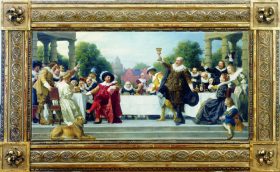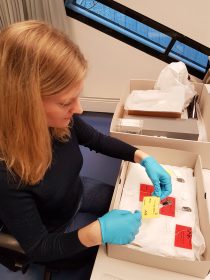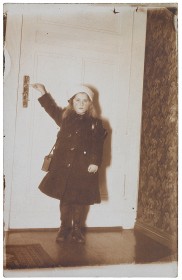– The Story of a Search

This oil sketch entitled Das Gastmahl der Familie Mosse (The Mosse Family Banquet) was restituted to the community of heirs of Felicia Lachmann-Mosse; Photo: Jewish Museum Berlin, Jens Ziehe.
Today is the International Holocaust Remembrance Day when we also remember the consequences of the criminal Nazi regime, which can still be felt today. One of these consequences is that a lot of museums are still holding cultural artifacts that were unlawfully confiscated from their owners during the Nazi era. Thus the Jewish Museum Berlin restored the oil sketch Das Gastmahl der Familie Mosse (The Mosse Family Banquet) to the heirs of Felicia Lachmann-Mosse in December last year. How was this decision reached? Provenance research has attracted increasing attention in recent years and caused frequent rumblings in the media – but how is it actually carried out? → continue reading
Object Lessons on our Museum’s History

Trainee Lisa Renner performing inventory; Jewish Museum Berlin, photo: David Studniberg
I still remember my first day of work at the museum well, some months ago. Together with two new colleagues, I rode the elevator one floor down, we passed through two secured doors, and there we were: in the warehouse. There on two iron shelves towered bulging boxes and cartons as well as all kinds of objects — and with them, my job for the next eight months as an academic volunteer at the Jewish Museum Berlin: to set up a little special exhibition on the history of the museum itself.
Somewhat at a loss, I rummaged through a hodgepodge of exhibition papers, invitations, and photographs of people I didn’t know, and asked myself what a wire-frame goose on skateboard wheels or an old elevator sign were doing in a museum. → continue reading
A Photo Collection Found Hiding in Berlin-Friedrichshain

A girl standing in front of a door, presumably Berlin, about 1918–1922; Jewish Museum Berlin
Every time I open a new folder of photos, I can’t know what’s waiting for me – what faces I’ll find or fates will be revealed. Images are often part of a larger collection, consisting of documents, everyday articles and artwork, for which we already know the biographies of those pictured or can further research. Such was the case, for example, of the cabaret artist, Olga Irén Fröhlich, whom I’ve written about before on this blog. This time, however, the people in the photographs will remain unknown to me; I won’t be able to attach names or histories to them. Perhaps you can!
It’s not out of the ordinary to work with collections that have been in the Museum’s possession for decades. → continue reading


